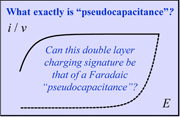Publication
824
ACS Appl. Mater. Interfaces, 9 (10), 8649-8658, 2017
DOI:10.1021/acsami.6b14100
|
|
|
|
|
|
 |
How Do Pseudo-Capacitors Store Energy? Theoretical Analysis and Experimental Illustration
|
|
|
|
Cyrille Costentin, Thomas R. Porter, Jean-Michel Savéant
Laboratoire d'Electrochimie Moléculaire, UMR 7591 CNRS, Université Paris Diderot, Sorbonne Paris Cité, 15 rue Jean-Antoine de Baïf, F-75205 Paris Cedex 13, France
Batteries and electrochemical double layer charging capacitors are two classical means of storing electrical energy. These two types of charge storage can be unambiguously distinguished from one another by the shape and scan-rate dependence of their cyclic voltammetric (CV) current–potential responses. The former shows peak-shaped current–potential responses, proportional to the scan rate v or to v1/2, whereas the latter displays a quasi-rectangular response proportional to the scan rate. On the contrary, the notion of pseudocapacitance, popularized in the 1980s and 1990s for metal oxide systems, has been used to describe a charge storage process that is faradaic in nature yet displays capacitive CV signatures. It has been speculated that a quasi-rectangular CV response resembling that of a truly capacitive response arises from a series of faradaic redox couples with a distribution of potentials, yet this idea has never been justified theoretically. We address this problem by first showing theoretically that this distribution-of-potentials approach is closely equivalent to the more physically meaningful consideration of concentration-dependent activity coefficients resulting from interactions between reactants. The result of the ensuing analysis is that, in either case, the CV responses never yield a quasi-rectangular response proportional to v, identical to that of double layer charging. Instead, broadened peak-shaped responses are obtained. It follows that whenever a quasi-rectangular CV response proportional to scan rate is observed, such reputed pseudocapacitive behaviors should in fact be ascribed to truly capacitive double layer charging. We compare these results qualitatively with pseudocapacitor reports taken from the literature, including the classic RuO2 and MnO2 examples, and we present a quantitative analysis with phosphate cobalt oxide films. Our conclusions do not invalidate the numerous experimental studies carried out under the pseudocapacitance banner but rather provide a correct framework for their interpretation, allowing the dissection and optimization of charging rates on sound bases. |

